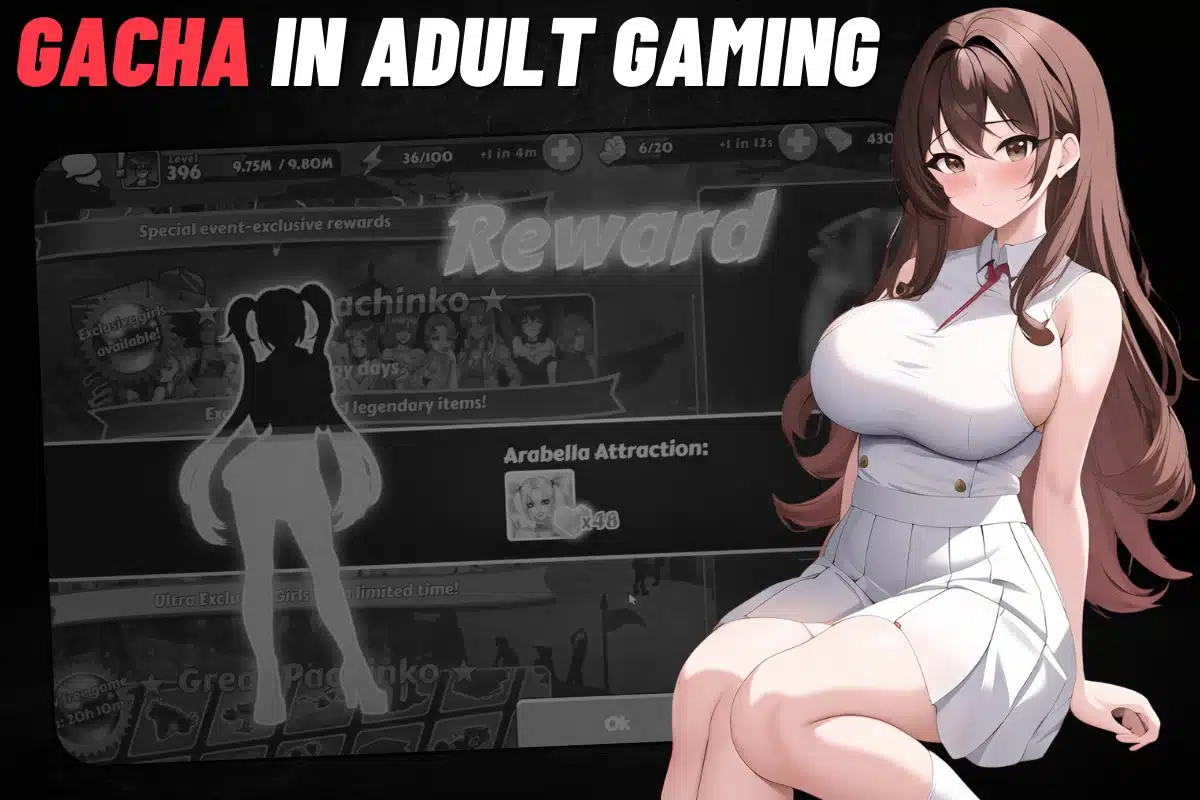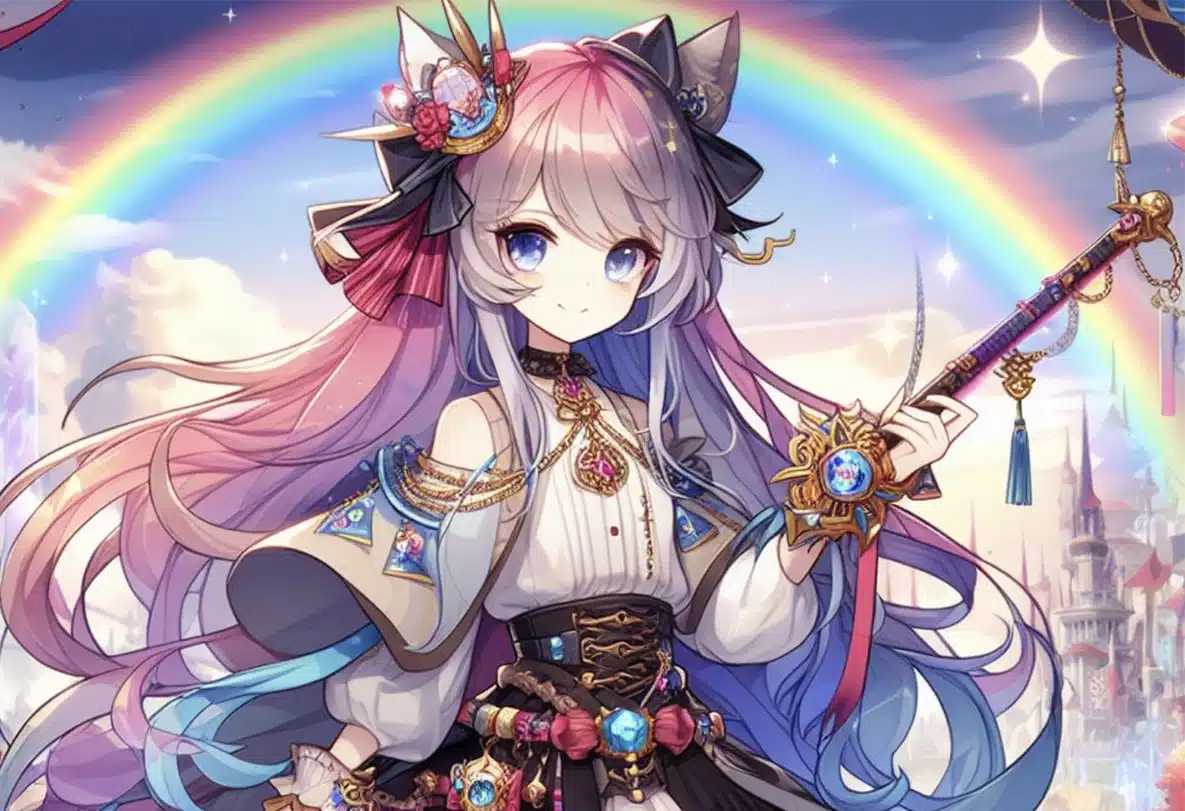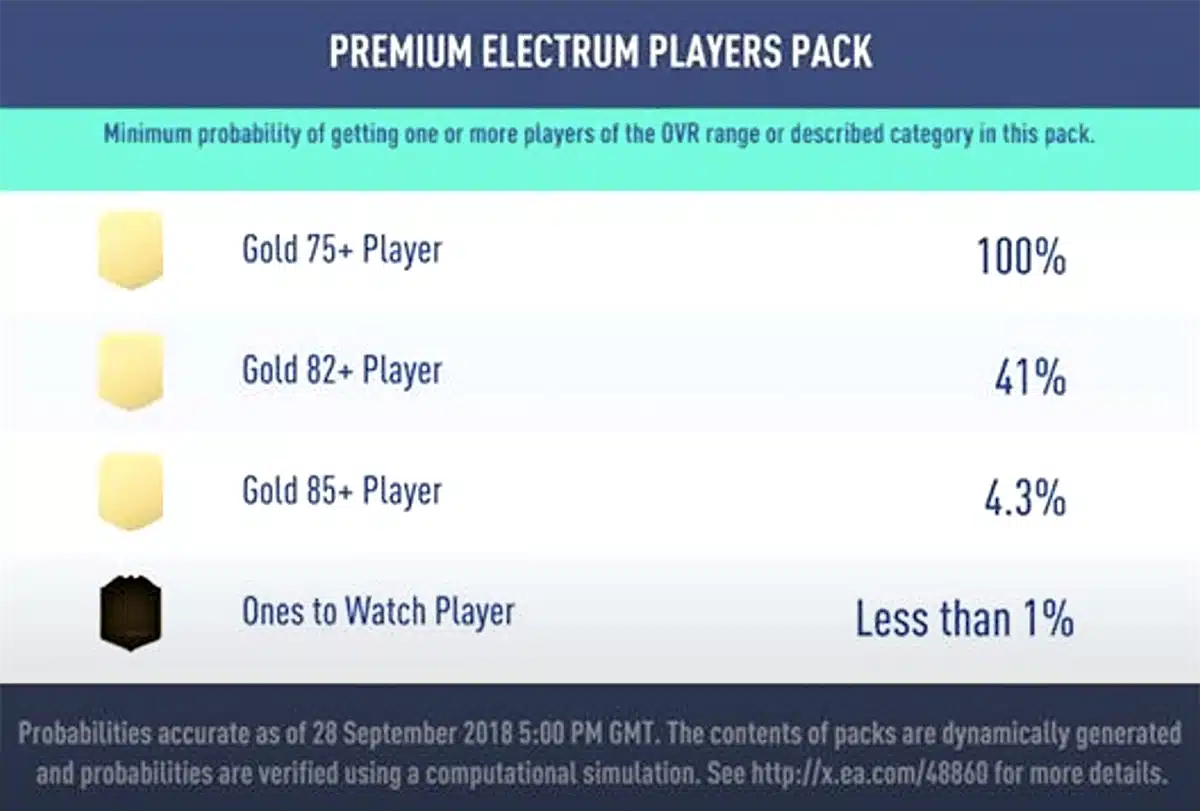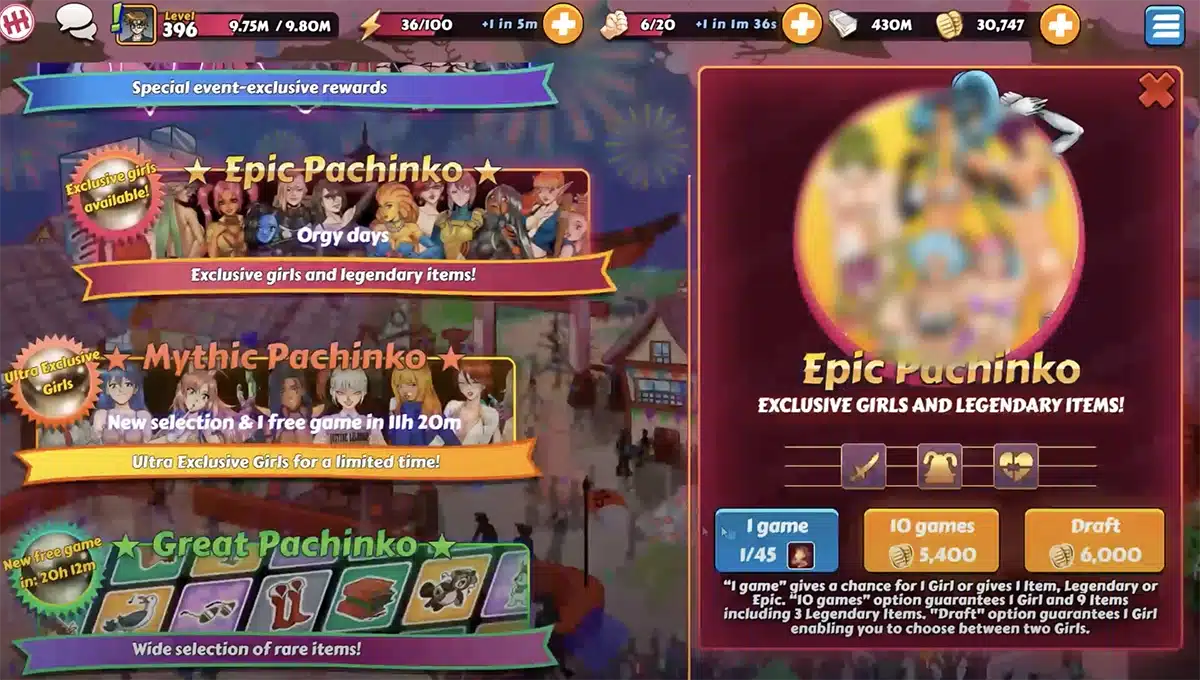Spend enough time playing Japanese adult games and you’re bound to encounter your first gacha game.
You’ll find gacha games throughout the Japanese pornographic games industry, and some of the biggest platforms (e.g. Nutaku below) are famous for offering them – so what are they?
Gacha is a ‘freemium’ business model for Japanese porn games. In most cases, it’s possible to get through the game if you play it for long enough, but you can also buy gacha items to help you make faster progress.
It’s basically a Pay-To-Win (P2W) cheat code for gamers who are happy to vote with their wallets.
There’s an element of chance involved – like a loot box mechanic, gacha items are a lucky dip, rather than buying a specific item, weapon or power-up from an in-game shop. Some games also give you one or more free gacha items per day, to encourage players to come back and to help get you hooked on gacha gambling.
All of this adds up to a uniquely addictive gameplay and begs the question, next time you’re grinding through a gacha game to reach the next cut scene with your virtual waifu: is the juice worth the squeeze?
Why Is It Called Gacha?

‘Gacha’ is a shortened form of ‘gachapon’ or ‘gashapon’, the name used in Japan for toy capsule vending machines.
Postcard and gumball vending machines existed in the USA and UK as early as the 1880s, but it wasn’t until 1965 that the first gachapon machine was installed in Japan.
Ryuzo Shigeta, a shopkeeper in the Taito Ward of Tokyo, bought an American vending machine. Unimpressed by the random toys and postcards spewed out by the machine, he wanted a ‘cleaner’ product, so he started putting small toys in plastic shells.
The name ‘gachapon’ came from the sound made by the machine – the ‘gacha-gacha’ of cranking the handle, and the ‘pon’ of the plastic egg dropping out. Shigeta – now known as the Grandfather of Gachapon – had invented a cultural revolution.
In 1977, Bandai trademarked the spelling ‘Gashapon’ and in 2023, the first official Gashapon stores opened in the USA, offering hundreds of machines stocked with anime toys, computer game characters and “anything kawaii“.
Gacha in Adult Gaming: A Match Made In Heaven

Porn games might sound a long way from toy capsule vending machines, but many of the underlying principles are the same. Since the early days of Japanese adult games, gacha mechanics have been built in as a way to monetise players, and to randomly generate power-up items and virtual collector cards.
In many games, buying a gacha item will trigger an animation showing a virtual gachapon machine, a spinning prize wheel, or some other representation of a real-world device. Other times, you might just open a loot box and receive a random item.
Each gacha purchase is usually a microtransaction, costing a few dollars or less, and may come with perks (e.g. remove advertising from a free game). But for players who get hooked on using gacha to speed through games and avoid the grind, that can add up to a big phone bill at the end of the month.
There’s a reason why our games editor, Mike, is so anti-gacha. 😉
Ultimately, there are outcomes for the player and for the game developer: players get through the game faster, for a price; developers generate additional revenues, which can allow them to invest more into future titles, and can cover the running costs of online games with 24/7 servers.
This is the basis on which many modern ‘free’ online games are built, not just the smutty Japanese variety found on mega networks like Nutaku.
What Are The Main Mechanics of Gacha Games?
Gacha games use a variety of different monetisation models and methods.
Do any of these sound familiar?
FOMO
FOMO and YOLO are the battle cries of a digital generation – and Fear Of Missing Out can be a powerful force when deciding to gamble on a gacha item.
This isn’t a uniquely gacha monetisation model. Limited-time sales and special offers are used to boost sales in everything from car dealerships to grocery stores, and combined with a You Only Live Once mentality, that can have you reaching for your credit card in an impulsive “fuck it” moment.
Intermediate Rewards
This is all about the grind. Intermediate rewards are given at shorter intervals through the game, to keep players engaged.
Paying a small fee will skip to the next reward – compared with putting in time and effort to reach a free gacha item, which will help the player to progress in the same way.
Price Anchoring
Price anchoring is about setting the player’s expectations of how much an in-game item ‘should’ cost, so that any limited-time special offers or bulk-buys sound like a better deal.
An example might be to offer in-game trading cards for $5 each, or a pack of five for $15. Players might think they’re getting 40% off, even though they would never have spent $25 on five individual cards, so haven’t really saved $10.
Near Miss
Isn’t it funny how on any in-game prize wheel, you always land just one space away from the jackpot?
This doesn’t really need explaining – the feeling of being ‘so close‘ to getting the specific item you needed can push many players into trying again, even though statistically you have no better chance of winning on your next attempt.
Open Gacha
Early gacha games often avoided telling players how likely they were to drop or pull a specific item – if something had only a 1% chance of appearing, players might be less likely to go for it.
That ‘closed gacha’ model has largely been replaced by ‘open gacha’, where item rarities are published somewhere in-game; however, if a player is feeling lucky, even a 1 in 1,000 shot might sound appealing.
If we look at the mainstream gaming world, any game on Google Play now has to disclose loot box odds so that gamers are aware of the chances of a ‘dub’.
Even EA’s legendary FIFA series had to cave to this new legislation, with Ultimate Team packs adjusted to show the percentage-based chances of pulling special-rated cards.

To the surprise of absolutely nobody, adult games have been much slower to follow the path towards full disclosure.
Pity
The brilliantly named ‘pity’ model is a guarantee that if you lose enough times, eventually you will win, giving players an idea of the maximum price they will have to pay to unlock a specific jackpot item.
Several pity mechanics are used in gacha games:
- Soft pity increases the chance to win the star prize with each losing spin
- Hard pity guarantees the star item will be awarded after a certain number of attempts
It’s pretty sweet to know that you’re guaranteed to get the item you need, if you try enough times, but it also plays into the ‘sunk cost’ fallacy – if you’ve racked up a few microtransactions already without success, it’s more tempting to keep going so you didn’t waste your money.
What Are The Different Types of Gacha?
As well as the monetisation mechanics listed above, there are some main types of gacha gameplay that can affect the logic and probability of going for a specific item…
Box Gacha
This is literally like pulling items at random from a box until you get the one you want – the box’s contents are finite and listed from the start, so you know exactly how many items there are, and your chance to get the one you need.
Complete Gacha
Complete gacha (or ‘compu gacha’ in Japanese) is like a two-dimensional gacha game mechanic. First, players must collect gacha trading cards in-game, with an element of chance deciding which cards they receive.
Once a set of cards is completed, then a rare item is unlocked as a reward, making it potentially very very difficult to obtain the item – so difficult, in fact, that this game mechanic was banned from social games in Japan in 2012.
Consecutive Gacha
Basically a bulk-buy for gacha pulls, drops or spins, with a discount for players who buy more, or an increased chance of winning something good.
Redraw Gacha
A re-roll mechanic means if a player doesn’t like their prize, they can trade it in for another spin, sometimes for free.
Step-up Gacha
This model rewards players who buy multiple spins within a period of time. That might be anywhere from just a few minutes, to better prizes for signing in several days in a row, and ties into the FOMO mechanic to keep players hooked.
The Pros & Cons of Gacha Adult Games
Adult gacha games are usually referred to as Hentai Gacha (or H-Gacha for short) and while the game mechanics are similar to non-pornographic games, there are obviously a few pros and cons that relate directly to their adult nature.

The Good
You Don’t Have To Pay
Remember, gacha games almost always have a ‘grind’ option that allows you to get through without paying. It’s not in the developers’ interest for you to give up completely.
In fact, they’ll often give you free gacha spins (e.g. once a day) to try to get you hooked, so if you’re patient, you can eventually get some pretty good items and bonuses for free.
But if we look at some of the most popular titles in the mobile gaming space, one thing is clear – your progress is gonna stall really fast if you don’t reach for that wallet.
You Set The Pace
With a bit of discipline, you can set your budget for in-game microtransactions, and so set the pace of progress through the game.
Some games and platforms allow you to set a spending limit, similar to online gambling sites, so the game will warn you (or stop you completely) if you rack up too much of a cost in one day, week or month.
This is fine, but can we be trusted to set our own pace?
Skip To The Action
If you’ve got the budget, H-Gacha games allow you to shortcut to the good stuff and leave the grind for the less fortunate.
Yes there’s a financial cost involved with doing this, but if you just want to see your waifu in all her glory, or add more characters to your harem of virtual girlfriends, that’s often just a few bucks away.
Games like Harem Heroes offer a very nice 669 characters to unlock, which will take a lifetime of grind, but gacha mechanics can cut that time massively.
The Game Might Not Exist Without It
Developers might give their games away for free, but somebody has to pay – or the dream ends for everybody.
This is just a simple reality of the new gaming economy. Many developers are sacrificing the initial payment to access a game, in the hope that a large enough percentage of the free playing masses will opt for micro-transactions and loot boxes.
I call it the Fortnite Formula.
Love it or hate it, a lot of your favorite smut titles wouldn’t be here without it.
The most viable alternative is to crowd-fund the development through sites like Patreon instead.
The Bad
Well… let’s start with this guy:
Time To Grind
In most cases if you spend nothing at all, the grind can be pretty time-consuming (“understatement of the century” according to our games expert, Mike!). The most popular H-Gacha games are usually those that reward players pretty fairly even without any cash purchases, but these hidden gems are increasingly difficult to find in a sea of developers putting out half-arsed wallet-suckers.
Still, the game mechanic is designed for you to buy your way through, so you should expect a certain amount of frustration if you’re committed to F2P (free-to-play) gameplay only.
Attack on Moe H is a perfect example of this. A lewd Pokemon-style hentai clicker, it starts at a pace, then grinds to a halt unless you spend on some gacha microtransactions.
If you see a game marketed as a clicker, you can rest assured that there’s probably a decent dose of gacha baked in to the title.
Rare Items
The rarest items are, well, pretty rare. Even if you pay to play, the element of chance means there’s no guarantee you’ll get the item you want (or the waifu you want, in character collection games).
Pity mechanics can offer some certainty, but at a financial cost, so it’s always worth being sure before you start investing your time and money into a new H-Gacha title.
Server Sunsets
If a game relies on access to a remote server to power the gacha items, limited-time offers and other gameplay mechanics, some day those servers will be switched off for the last time.
Gacha helps to keep online games profitable for the developers, but when a title is no longer making its money, it will eventually be retired. If you’ve sunk a lot of time, money, and emotional connection into a specific game or virtual girlfriend, it can be hard to make that break. Even if it’s probably for the best!
Gacha in Adult Gaming: A Dirty (Expensive) Pleasure
Gacha games have something to offer no matter what your budget is (how about a big fat zero?), and there’s some satisfaction to be found in unlocking a rare item or god-tier waifu after putting hours and hours into your grind, without spending a penny.
Most of these games are designed to leave you with two choices: grind for free in F2P mode, or buy some in-game currency and let some gacha pulls turbo-charge your progress.
It doesn’t take a genius to work out which option the developer would prefer, and that’s reflected in game design that feels like it wants to milk you for all its worth.
Gacha games are never going to win a declared popularity contest. They’re more akin to a dirty pleasure. Too addictive to put down, too tempting to resist.
Our advice? Spend your pennies responsibly!

